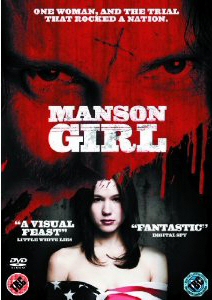
(aka 'Leslie, My Name is Evil' aka 'Manson, My Name is Evil')
What causes average girls to commit decidedly non-average acts? This is the central question of Canadian courtroom thriller Manson Girl, which focuses on the teenage years of one Leslie Van Houten (only referred to as Leslie here, though, and never by her surname) - better known as Manson family gal and convictee of the infamous LaBianca murders of 1969.
The film starts and ends with the Manson trial, returning to Leslie's formative years only to consider how she came to throw in her lot with Charlie Manson. Her past is skipped over quite quickly but the implication is that her parents' divorce, her early sexual relationship with sometime-'family' member Bobby Beausoleil and her subsequent abortion all contributed to pushing her away from mainstream society. Oh, and all that LSD probably didn't help. Whilst in the throes of an acid trip, Leslie falls in with some other middle-class-gone-bad girls by the names of Susan ('Sadie') and Patricia; they share their feelings of alienation, and the two girls promise that their living God, Charlie, has the answers Leslie seeks…
As a parallel, we're shown how a decidedly moral and conventional young man will eventually cross paths with the Manson crowd. Perry goes to church, doesn't fancy the idea of the Vietnam draft, and is planning to marry his fiancée Dorothy (though this is largely so he can get his end away without offending God). When he lands a corporate laboratory job (making 'pesticides') which allows him to dodge the draft, he's around to be called as a juror for a certain infamous case…but this is all still to come. Meanwhile, down at the ranch, life for Leslie is a heady round of sex, acid and indoctrination. Bobby's occasional presence has the capacity to generate bad vibes, but family is family, and so when he's locked up, the Mansons distortedly show their solidarity by going out on a 'pig' killing spree.
Thereafter, we're back to the courtroom. The crimes themselves are largely contextual, and only the presence of some gore/nudity-happy flashbacks and fantasy sequences prevents this film from being a straightforward court drama. What it does, in a fairly low-key way, is to look at social hypocrisy. This means playing fast and loose with the facts of the Manson case and some important courtroom details which those in the know may well find infuriating.
The all-American couple Perry and Dorothy provide a diverting contrast from the goings-on Chez Manson, and - again, in a fairly gently-satirical way - points to America's fascination with its own seamy side. Perry as a juror becomes fascinated with Leslie despite knowing, and feeling, that he ought to be repulsed. It's between his duty to his country - bombing the shit out of Vietnam at that time - and his duty to his own conscience - all spiced up with a fantasised orgy scene!
The film pays homage to the cultural climate of the late 1960s in its delivery: it intersperses its linear narrative with 'trippy' sequences and newsreel footage which feels like a more accessible take on the Jim Van Bebber-directed Manson Family. This works quite well as a backdrop to the action, helping to ground the film in its era and develop a sense of the hypocrisy at the heart of the decade of 'free love'. Also to the film's credit, the casting of the actresses who play Sadie, Patricia and Leslie is spot on. The physical likenesses are very good indeed, and they all demonstrate a good sense of the mindless ferocity which emerged out of their LSD fug. However, and although Charlie here is a tangential figure really, I feel that he was miscast. His performance is adequate, but he lacks the spry malevolence - and the charisma - of the man himself, who after all was the catalyst for the whole murder case.
I also thought it was strange that the filmmakers chose the Manson case but shied away from actually naming the most infamous victim - Sharon Tate - or giving the girls their full names either. Possibly this is due to some legal precedent concerning victims' families or perpetrators who are still living, or it could be that the filmmakers wanted to use the case merely as a starting-point to satirise society's take on criminality. Whatever the reason, it felt to me as a viewer that the film slightly held out on its subject matter, choosing as it did such a world-renowned murder case.
That said, minor quibbles aside, this was a very watchable, entertaining and accessible film which provides a reasonable handle on 60s America through some clever use of devices like flashback, dream sequence and music. By no means a factual retelling, it is instead a look at some troubled times via some disparate young Americans. Manson purists might find themselves disappointed, but there is plenty to the credit of this spin on the case.
Review by Keri O'Shea
| Released by Momentum Pictures |
| Region 2 - PAL |
| Rated 18 |
| Extras : |
| see main review |